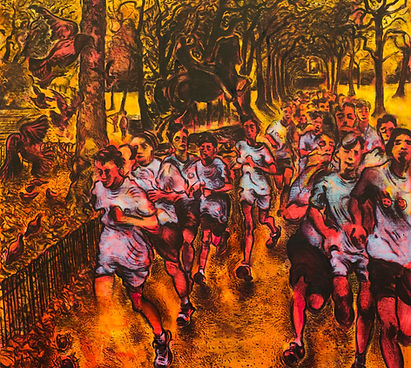
Simon Page
Drawn To Travel
Joseph O'Neill
Since the epoch of cave paintings, makers of art have typically privileged the studio and the special investigation that working in a sheltered space may facilitate. The indoor investigator has on his or her side obvious advantages, among them immobilization (of artist and subject); materials and amenities; and, most important perhaps, time. Working comfortably, statically and at length enables the prolonged noticing and reworking that we associate with the quest to make a 'finished' or 'perfected' visual thing.
The inverted commas express modern misgivings about the feasibility and aptness of the quest. Modernity, in this context, goes back to Charles Baudelaire, who coined the term in order to describe the dimension of experience newly offered to, and by, the flaneur. the receptive urban wanderer (and his relatives, the tourist and the drifter and the rambler) of course became an indispensable protagonist of modern culture. He figures in countless fictions and underwrites, famously, the speculations of Walter Benjamin and the photographs of Henri cartier-Bresson; but even they did not foresee our world of handhelds, in which we have no option but to become technicians of the ephemeral.
The travel drawings by Simon Page enter this visual crisis. Situated somewhere between the tweet and the atelier, they propose a kind of looking that embraces the temporary perpsective even as it rejects electronic instantaneity. The result is a distinctive openness and velocity of observation. These drawings are pithy. They seem free, and their freedom, it seems, happily infects the eye and the hand of the artist, who cannot avoid - and indeed seeks out - implication in the feelings and doings of his subjects. There is a profound human proximity in tese drawings. They depict us (on holiday, at leisure) in states of defenselessness, and yet they do not exercise power over us. An ethics of seeing reveals itself.

Physical Energy
Rachel Campbell Johnston
A flood of runners, fists clenched and feet pounding, comes pouring towards you. Lines of trees and park railings form channels along which they gush: a torrent of heart-pumping, breath-gasping humanity merging and jumbling into a great jostling flow.
Standing as if plunged right amid them, you can almost feel yourself brace as you look. No wonder the pigeons are sent madly scattering. Even the stone bison of the Albert Memorial is roused to new life. As the boys surge round the base of the pedestal upon which for more than 150 years it has stood, a stolidly implacable monument to the New World, it appears suddenly to waken and shake its rough pelt with an impatient snort.
Simon Page has been teaching art to the students at Harrow for some 30 years now. These images capture with a freshness that will always somehow feel current a variety of memories from his time at the school.
It is no accident that this show borrows its title – Physical Energy – from the totemic equestrian statue that stands, at a star-like confluence of pathways, in the middle of London's Kensington Gardens. Cast from a sculpture by the Victorian idealist George Watts, it speaks of his dream that his work should inspire those who saw it to believe in and so embrace a spirit of progress. It is this sense of possibility which Page's work also sets out to capture.
Our word “educate” derives from the Latin ducere: to draw out or lead. Page, quite literally, draws out the energy of youth in his pictures. Anything from a mountain camping trip through a music concert to a maths test might become his subject matter. He captures the atmospheric essence in eloquent sketches. Here is a boy reading, for instance. His shoulders slump. His hair flops forward. His lower lip falls slack. An air of intense concentration is locked into this image. How different this solitary study feels from Murmuration – getting settled: a sea of heads heaving like the surface of water as it gradually calms in the wake of some flurried disturbance.
Page allows line to think for itself. Follow the sweep of the crayon as it flows through languorous limbs, interlinking the teenagers who drowse in the afternoon heat on the banks of a pool. Compare this to the quivering flicker of an etching which shows those very same bathers later in the evening. They hug their shoulders and shiver as they huddle in freezing waters. In the larger paintings, in which the snapshot style spontaneity of the sketch is translated into a more finished picture, colour is introduced to intensify the effects. It burns like the muscles of runners who are pushed to their limits. It explodes like a burst of adrenalin.
These pictures ostensibly speak of the ways in which, when an individual is drawn out, when his energies (whether physical or mental) are channelled, they can discover a fresh power which will carry them forwards into the future. This sense of vivacity is transferred to the viewer. That is what makes these pictures so striking. They are more than just records of bygone memories. They speak, instead, of a living force which drives progress. And as such they are infused with that spirit of irrepressible hope which should underpin every student's education.
(The work was shown at The Old Speech Room Gallery, Harrow School and at Daniel Crouch, Bury Street in 2018)
